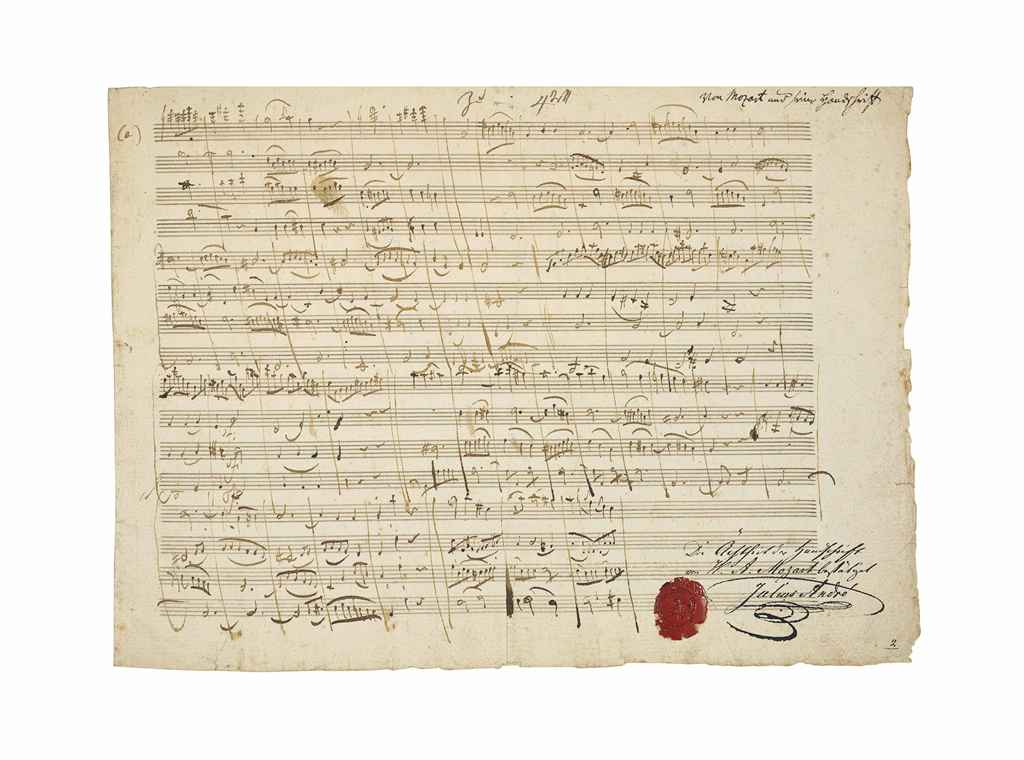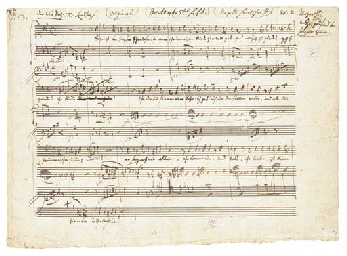MOZART, Wolfgang Amadeus (1756-1791). Autograph music manuscript, 'Marcia' for piano, the March in C, K.408/1, Mozart's own piano transcription, n.d. [1782], 72 bars in 9 systems of two staves, title in autograph, with A DRAFT OF AN APPARENTLY UNKNOWN MELODY added at foot in autograph, comprising the complete melody of a bourrée in E minor, 27 bars, together 1½ pages, oblong 4to (230 x 315mm) , a number of endorsements including 'Mozarts Handschrift' (by Nissen), the number '5' (perhaps by Maximilian Stadler), 'Breitkopf 6tes Heft' (unknown), the date '1782' (by André), the number '255' (Gleissner) and the number '56' (unknown); indecipherable annotation in red to lower left margin (?'... Mozart, Preis ...'), (some browning and fraying of margins). Provenance : Mozart's estate; André, Offenbach (1800); August André, Offenbach (1854); Anton Schmid, k.k. Hofbibliothekar, Vienna; F. Butsch; Slg. Count Ludwig Paar; Professor Lammers, Petershagen bei Berlin (Köchel 3), bought by him at Liepmannsohn Auktion, Berlin, 1929, no.14; untraced at the time of Köchel 6 (1964). A MARCH WRITTEN FOR CONSTANZE, WITH AN UNKNOWN SKETCH. The three marches for orchestra, K.408, were originally composed in 1782, presumably for one of Mozart's concerts in Vienna. 1782 was also the year of Mozart's marriage, and a letter from Constanze to Breitkopf & Härtel of 25 February 1799, referring to this work, indicates that either the original march or perhaps even this particular transcription was written for her: 'Ich sende Ihnen hiemit die 6 Sonaten und den Marsch, die Sie verlangt haben. Sie haben ganz Recht, daß der Anfang dieses Marsches mit dem in Idomeneo Ähnlichkeit hat. Sie werden aber bald die Verscheidenheit erkennen. Mein seliger Mann hat ihn für mich gemacht. Da ich versäumt habe, ihn abcopiren zu lassen, so schicke ich ihn im Original' [I enclose the six sonatas and the march you asked for. You are quite right that the beginning of this march has some similiarities to the one in Idomeneo . But you will soon recognise the difference. My late husband made it for me. As I have neglected to have it copied, I am sending it in the original manuscript]. The intriguing melody added at the foot of the manuscript is apparently unknown and unpublished; it is an attractive 27-bar bourrée of the sort that Mozart might use as an episode of a rondo-finale. NMA, vol IX/27/2, pp.137-139. The autograph manuscript of the orchestral version is in the British Library (Zweig MS. 54). We are grateful to Professor Neal Zaslaw for his help in cataloguing this manuscript.
MOZART, Wolfgang Amadeus (1756-1791). Autograph music manuscript, 'Marcia' for piano, the March in C, K.408/1, Mozart's own piano transcription, n.d. [1782], 72 bars in 9 systems of two staves, title in autograph, with A DRAFT OF AN APPARENTLY UNKNOWN MELODY added at foot in autograph, comprising the complete melody of a bourrée in E minor, 27 bars, together 1½ pages, oblong 4to (230 x 315mm) , a number of endorsements including 'Mozarts Handschrift' (by Nissen), the number '5' (perhaps by Maximilian Stadler), 'Breitkopf 6tes Heft' (unknown), the date '1782' (by André), the number '255' (Gleissner) and the number '56' (unknown); indecipherable annotation in red to lower left margin (?'... Mozart, Preis ...'), (some browning and fraying of margins). Provenance : Mozart's estate; André, Offenbach (1800); August André, Offenbach (1854); Anton Schmid, k.k. Hofbibliothekar, Vienna; F. Butsch; Slg. Count Ludwig Paar; Professor Lammers, Petershagen bei Berlin (Köchel 3), bought by him at Liepmannsohn Auktion, Berlin, 1929, no.14; untraced at the time of Köchel 6 (1964). A MARCH WRITTEN FOR CONSTANZE, WITH AN UNKNOWN SKETCH. The three marches for orchestra, K.408, were originally composed in 1782, presumably for one of Mozart's concerts in Vienna. 1782 was also the year of Mozart's marriage, and a letter from Constanze to Breitkopf & Härtel of 25 February 1799, referring to this work, indicates that either the original march or perhaps even this particular transcription was written for her: 'Ich sende Ihnen hiemit die 6 Sonaten und den Marsch, die Sie verlangt haben. Sie haben ganz Recht, daß der Anfang dieses Marsches mit dem in Idomeneo Ähnlichkeit hat. Sie werden aber bald die Verscheidenheit erkennen. Mein seliger Mann hat ihn für mich gemacht. Da ich versäumt habe, ihn abcopiren zu lassen, so schicke ich ihn im Original' [I enclose the six sonatas and the march you asked for. You are quite right that the beginning of this march has some similiarities to the one in Idomeneo . But you will soon recognise the difference. My late husband made it for me. As I have neglected to have it copied, I am sending it in the original manuscript]. The intriguing melody added at the foot of the manuscript is apparently unknown and unpublished; it is an attractive 27-bar bourrée of the sort that Mozart might use as an episode of a rondo-finale. NMA, vol IX/27/2, pp.137-139. The autograph manuscript of the orchestral version is in the British Library (Zweig MS. 54). We are grateful to Professor Neal Zaslaw for his help in cataloguing this manuscript.
MOZART, Wolfgang Amadeus (1756-1791). Autograph music manuscript, 'Marcia' for piano, the March in C, K.408/1, Mozart's own piano transcription, n.d. [1782], 72 bars in 9 systems of two staves, title in autograph, with A DRAFT OF AN APPARENTLY UNKNOWN MELODY added at foot in autograph, comprising the complete melody of a bourrée in E minor, 27 bars, together 1½ pages, oblong 4to (230 x 315mm) , a number of endorsements including 'Mozarts Handschrift' (by Nissen), the number '5' (perhaps by Maximilian Stadler), 'Breitkopf 6tes Heft' (unknown), the date '1782' (by André), the number '255' (Gleissner) and the number '56' (unknown); indecipherable annotation in red to lower left margin (?'... Mozart, Preis ...'), (some browning and fraying of margins). Provenance : Mozart's estate; André, Offenbach (1800); August André, Offenbach (1854); Anton Schmid, k.k. Hofbibliothekar, Vienna; F. Butsch; Slg. Count Ludwig Paar; Professor Lammers, Petershagen bei Berlin (Köchel 3), bought by him at Liepmannsohn Auktion, Berlin, 1929, no.14; untraced at the time of Köchel 6 (1964). A MARCH WRITTEN FOR CONSTANZE, WITH AN UNKNOWN SKETCH. The three marches for orchestra, K.408, were originally composed in 1782, presumably for one of Mozart's concerts in Vienna. 1782 was also the year of Mozart's marriage, and a letter from Constanze to Breitkopf & Härtel of 25 February 1799, referring to this work, indicates that either the original march or perhaps even this particular transcription was written for her: 'Ich sende Ihnen hiemit die 6 Sonaten und den Marsch, die Sie verlangt haben. Sie haben ganz Recht, daß der Anfang dieses Marsches mit dem in Idomeneo Ähnlichkeit hat. Sie werden aber bald die Verscheidenheit erkennen. Mein seliger Mann hat ihn für mich gemacht. Da ich versäumt habe, ihn abcopiren zu lassen, so schicke ich ihn im Original' [I enclose the six sonatas and the march you asked for. You are quite right that the beginning of this march has some similiarities to the one in Idomeneo . But you will soon recognise the difference. My late husband made it for me. As I have neglected to have it copied, I am sending it in the original manuscript]. The intriguing melody added at the foot of the manuscript is apparently unknown and unpublished; it is an attractive 27-bar bourrée of the sort that Mozart might use as an episode of a rondo-finale. NMA, vol IX/27/2, pp.137-139. The autograph manuscript of the orchestral version is in the British Library (Zweig MS. 54). We are grateful to Professor Neal Zaslaw for his help in cataloguing this manuscript.
MOZART, Wolfgang Amadeus (1756-1791). Autograph music manuscript, 'Marcia' for piano, the March in C, K.408/1, Mozart's own piano transcription, n.d. [1782], 72 bars in 9 systems of two staves, title in autograph, with A DRAFT OF AN APPARENTLY UNKNOWN MELODY added at foot in autograph, comprising the complete melody of a bourrée in E minor, 27 bars, together 1½ pages, oblong 4to (230 x 315mm) , a number of endorsements including 'Mozarts Handschrift' (by Nissen), the number '5' (perhaps by Maximilian Stadler), 'Breitkopf 6tes Heft' (unknown), the date '1782' (by André), the number '255' (Gleissner) and the number '56' (unknown); indecipherable annotation in red to lower left margin (?'... Mozart, Preis ...'), (some browning and fraying of margins). Provenance : Mozart's estate; André, Offenbach (1800); August André, Offenbach (1854); Anton Schmid, k.k. Hofbibliothekar, Vienna; F. Butsch; Slg. Count Ludwig Paar; Professor Lammers, Petershagen bei Berlin (Köchel 3), bought by him at Liepmannsohn Auktion, Berlin, 1929, no.14; untraced at the time of Köchel 6 (1964). A MARCH WRITTEN FOR CONSTANZE, WITH AN UNKNOWN SKETCH. The three marches for orchestra, K.408, were originally composed in 1782, presumably for one of Mozart's concerts in Vienna. 1782 was also the year of Mozart's marriage, and a letter from Constanze to Breitkopf & Härtel of 25 February 1799, referring to this work, indicates that either the original march or perhaps even this particular transcription was written for her: 'Ich sende Ihnen hiemit die 6 Sonaten und den Marsch, die Sie verlangt haben. Sie haben ganz Recht, daß der Anfang dieses Marsches mit dem in Idomeneo Ähnlichkeit hat. Sie werden aber bald die Verscheidenheit erkennen. Mein seliger Mann hat ihn für mich gemacht. Da ich versäumt habe, ihn abcopiren zu lassen, so schicke ich ihn im Original' [I enclose the six sonatas and the march you asked for. You are quite right that the beginning of this march has some similiarities to the one in Idomeneo . But you will soon recognise the difference. My late husband made it for me. As I have neglected to have it copied, I am sending it in the original manuscript]. The intriguing melody added at the foot of the manuscript is apparently unknown and unpublished; it is an attractive 27-bar bourrée of the sort that Mozart might use as an episode of a rondo-finale. NMA, vol IX/27/2, pp.137-139. The autograph manuscript of the orchestral version is in the British Library (Zweig MS. 54). We are grateful to Professor Neal Zaslaw for his help in cataloguing this manuscript.




.jpg)





.jpg)

Testen Sie LotSearch und seine Premium-Features 7 Tage - ohne Kosten!
Lassen Sie sich automatisch über neue Objekte in kommenden Auktionen benachrichtigen.
Suchauftrag anlegen